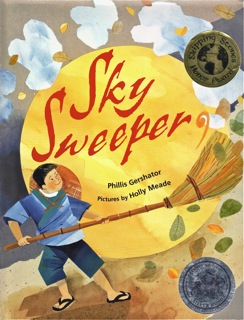|
|
|

|
Sky
Sweeper
illustrated
by Holly Meade
Melanie Kroupa Books
Farrar, Straus and Giroux, 2007
|
*Starred
review,
Kirkus
*Parents
Choice
Silver Award, 2007
*S&P
Book
Awards:
Best Spiritual Books of 2007
*Starred
review,
Library Media Connection
*Skipping
Stones
Honor Award:
Multicultural and
International Books, 2008
*Lupine
Picture
Book Honor Award, 2007
*Capitol
Choices Noteworthy Titles for
Children and Teens, 2008
|
| From
the book jacket: |
Can a
single flower say more than
words?
Young
Takeboki needs a job, and the
monks in the temple need a
Flower Keeper--so Takeboki sets
to work. It’s the Flower
Keeper’s job to sweep up the
springtime plum and cherry
blossoms in the temple garden.
As the seasons change, Takeboki
continues to find pleasure in
doing his job well--sweeping up
flowers and leaves and snow--and
then creating swirling worlds of
his own in the gravel and sand
of the temple garden.
Friends
and family ask him: Shouldn’t
you get a better job? Wouldn’t
you like to see more of the
world? Takeboki can’t answer
those questions. All he knows is
that as the seasons shift, each
one as beautiful as the last, he
is happy.
Luminescent collage
illustrations created from
delicate Japanese papers bring
to life this thought-provoking
parable that, with its Buddhist
sensibility, has much to say
about work, wisdom, and the
possibility of discovering a
world of unending delight in one
small garden.
|
| A
little about the book: |
When I read about an old-time job in
Japan, that of Flower Keeper, the
words and image stayed with me, and a
story began to unfold and evolve over
the years. I was helped by my readers,
especially Holly Meade, who had a
vision of how the text would work as a
picture book and how it could be
simplified to focus on its most
important messages about life, work,
and happiness.
It
makes me happy when I look at Holly's
beautiful artwork (her site:
http://reachroadgallery.com/ )–– and
it makes me happy to hear the
different “lessons” people draw from
the Flower Keeper's story.
The story might touch off a classroom
discussion, an exploration of
philosophical questions such as: What
is play? What is work? What makes a
good life? And of course, What makes a
person happy?
When I read Sky
Sweeper to
Elisabeth Anderson’s class at Antilles
School in St. Thomas, her fourth
graders responded with a group poem
about happiness:
WHAT
MAKES ME HAPPY?
by Class 4A
What makes me
happy?
Reading gives me a good feeling
Basketball – I like to get the ball in
the hoop
My PS2 – it’s electronic!
What makes me
happy?
Sailing – it’s my sport
Gliding across the water
Traveling around the world
Going sight-seeing
Swimming
I like to be under water
It’s nice and warm
What makes me
happy?
Gymnastics - being on my hands
instead of my feet
Golf – I’m good at it
I like to swing my driver
My Xbox – ‘cause I can control
the person in the game
What makes me
happy?
Playing with my kitty
I roll up a tin foil ball
and she pounces on it
My parakeet--teaching it to sing
Sometimes it chirps
loudly and annoyingly
but sometimes it chirps
sweetly
Football – I like to score
What makes me
happy?
Kick ball
I like to kick the ball
Jumping in the pool
feeling the freezing
water
Sleeping - I can be unconscious
I don’t know what’s going
on
If something bad happens,
I won’t remember
When I’m awake -
acting
expressing a
character
What makes me
happy?
Holidays
You get to be with your family
You get to get to spend time with them
You love them
And they love you.
And then someone in the class asked,
“What makes us
ALL happy?
And his classmates answered,
“Eating!”
In the
classroom, the Flower Keeper's story
might also lead to an exploration of
Japanese literary forms: haiku and
haibun. Writing haiku is already a
popular activity, but I’m hoping
children will be encouraged to write without
the seventeen syllable rule as an
absolute. In fact, seventeen syllables
create a poem that is often too long
and wordy to be called a haiku. The
Haiku Society of America adopted this
definition:
1) An un-rhymed Japanese poem
recording
the essence of a moment keenly
perceived,
in which Nature is linked to human
nature.
It usually consists of seventeen onji
[sound units].
2) A foreign adaptation of 1, usually
written
in three lines totaling fewer than
seventeen syllables.
Most
important of all is the “haiku
spirit.” In her terrific teacher’s
manual, The Haiku Habit Workshop,
Jeanne Emrich writes: “The haiku way
is just to say it--simply. Written in
a very direct manner, haiku tell the
who, what, where, and when of the
moment as the author perceived it
through his or her senses. The result
of such a concrete description is that
the reader feels as if he or she also
is having the experience. And because
commentary is kept to a minimum, the
reader is free to come to his or her
own conclusions about what the
experience means....”
Haibun is
prose--a story, impression, incident,
description--which includes haiku. Sky Sweeper
concludes with a haiku by Moritake,
one of the most famous haiku in
Japanese literature. It evokes the
garden setting for me, and the
mysteries, delights, and surprises one
encounters in a garden. If one wishes
to seek out connections, Moritake’s
haiku relates to the story through the
image of the blossom. Blossom is a
“seasonal word,” which many haiku
contain to indicate time and place. It
represents spring, a time of birth and
rebirth, and a connection to the
Flower Keeper’s job as well.
The
butterfly, a creature of fragile
beauty, with a magically dramatic life
cycle, also symbolizes life’s
preciousness--and transience. Is it
any wonder that, for some Japanese,
butterflies represent the souls of the
dead?
I like to
think that the Sky Sweeper lives on,
if not in the butterfly, then in the
spirit of the young gardener who
follows in his footsteps and shares
his knowledge and his happiness.
I would also
like to think, along with caring for
the temple garden, that the Flower
Keeper cultivated “the seeds of
compassion," as Thich Nhat Hanh put
it.
When I
was working on Sky Sweeper,
my daughter introduced me to the
writing of Thich Nhat Hanh, a Zen
Buddhist monk who has become one of
the truly spiritual voices of our
time. His teachings promote the
attainment of peace for ourselves and
for the world. For example, by not
responding to anger with anger, we can
create the possibility of turning our
enemies into friends. Imagine if we
lived in a world governed by the
teaching of non-violence!
In an article
in Yoga
Journal (Sept./Oct. 2003),
Thich Nhat Hanh describes
Buddha’s transformation of the
arrows of Mara, the Evil One, into
flowers. Transforming negative
emotions into positive ones, he
writes, will transform ourselves and
others: “You soon see that arrows shot
at you come out of other people’s
pain. You do not feel injured...;
instead you have only compassion....”
He acknowledges this may be difficult
but teaches that, in this way, “We can
all make flowers out of arrows.”
To those who do not
recognize the value of his work and
feel he should take a less
“lowly” path in life, the Flower
Keeper responds not with anger but
with empathy and good humor, a fitting
response for one who will ultimately
smile with the inner peace and
contentment of Buddha himself, the
same Buddha who smiled in his flowery
victory over Mara.
|
| From
the reviews: |
“Infused with a Buddhist sensibility,
written in clear, minimalist language,
accompanied by rich, organic
illustrations and culminating in a
haiku by Moritake, this is an
origiinal fable not to be missed.” Kirkus,
starred review.
"This is a complex, challenging story.
Children will need help connecting
Gershator’s poetic, often
Zen-influenced messages about
Takeboki’s sense of purpose and
personal reward; his death adds even
more weight to the story. But Meade’s
beautiful collage illustrations of the
earthly garden and glorious afterlife
greatly enhance the story’s
accessibility and will help kids get
closer to the text’s religious and
philosophical themes." Booklist
"Only after the old man's death do the
monks realize that his humble work has
nourished their own serenity. Takeboki
himself graduates to a perfect heaven
(for him): now he sweeps the sky. As
Gershator explains in a note, her
story celebrates the rewards of
meaningful work as well as the
artistry of Japanese gardens. Meade's
mixed-media illustrations (collage,
paint, delicate line) intimately
depict the dedication to a
simple-seeming task that is, in truth,
an art." Hornbook
“The illustrations provide a
bit of foreshadowing, incorporating
the figure of another smiling boy, the
future Flower Keeper, in later
scenes.... Nicely constructed for
reading aloud, this quiet story has a
satisfying progression that might
prompt reflective discussion.” School
Library Journal
"As Gershator's (Rata-Pata-Scata-Fata)
resonant, lyrical tale opens,
young Takeboki takes a job as a Flower
Keeper for the temple monks. Though
his task is to sweep up the fallen
plum and cherry blossoms in their
garden in spring, the conscientious,
content worker continues sweeping
through the other seasons--and many of
them....Created from Japanese papers,
Meade's (Hush!) richly
textured, luminous collage
illustrations are as simple and
graceful as Gershator's narrative.
Like Takeboki's, theirs is a job well
done." Publishers Weekly
"It is a beautiful story in
both text and illustration. An
intriguing range of paper textures was
employed in creating all the collages
where one finds children playing and
people working. Two kinds of
Japanese/Buddhist gardens are
represented in the mixed-media
illustrations: the Hill-and-Pond style
garden and the Dry Landscape garden.
Due to the sophisticated theme, this
will find its greatest audience among
older children and young adults. It is
a story that would generate a lot of
discussion with middle and high school
students on a career day."
Children's Literature
"'Our age,' wrote Simone Weil
just before her death in 1943, 'has as
its own particular mission, or
vocation, the creation of a
civilization founded upon the
spiritual nature of work.' Yet today
children grow up with few models of
individuals who love their jobs and
try each day to do them to the best of
their ability. That's why this
inspiring beautifully illustrated book
by Phillis Gershator is so welcome." Spiritualityandpractice.com
The serenity of a Japanese temple
garden is captured in airy watercolor
and collage in this tribute to the
sustenance that is found in work and
beauty.... Each beautifully composed
page glows with clean color and the
delicate prints of origami paper.
Takeboki's gentle soul is central both
to the pictures and the spare text.
This is a satisfying and
thought-provoking book to share.
Highly recommended. Library
Media Connection, starred
review
Art by Holly Meade
|

|
|
|
|